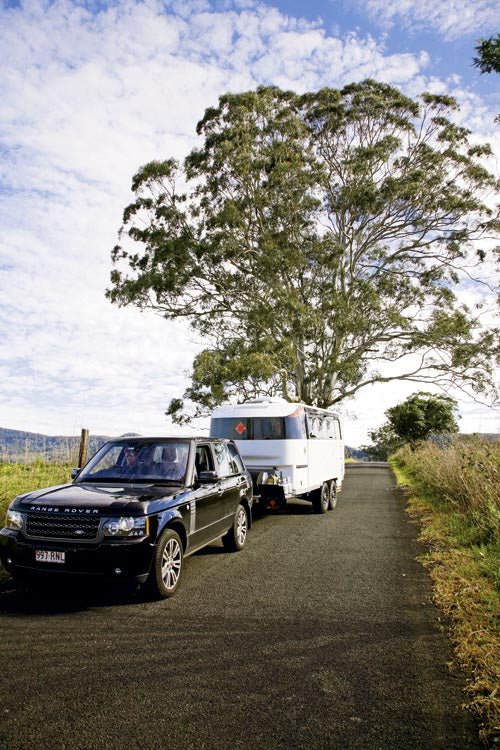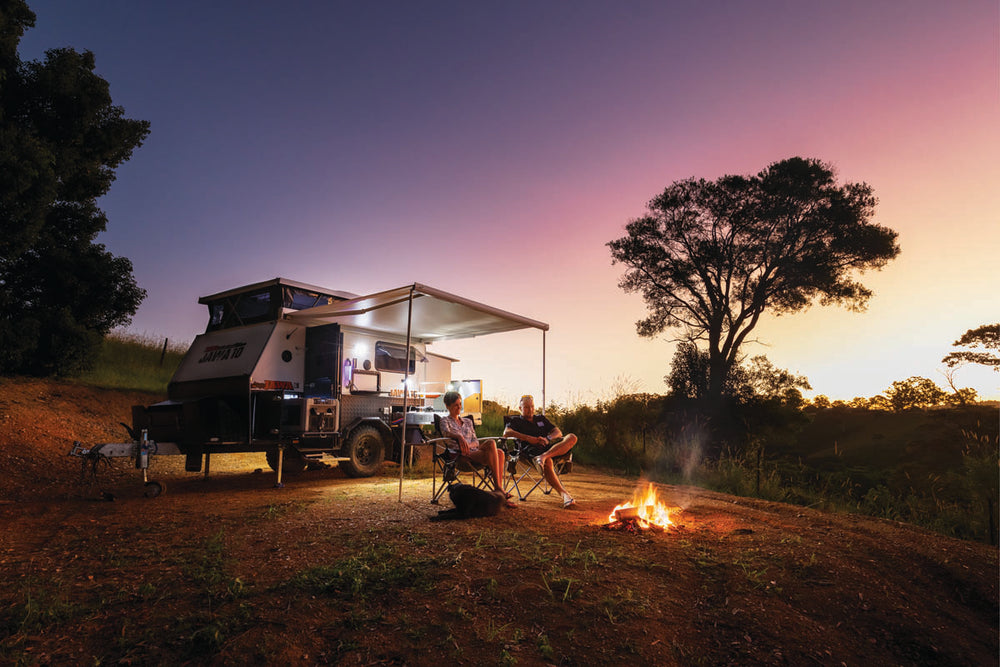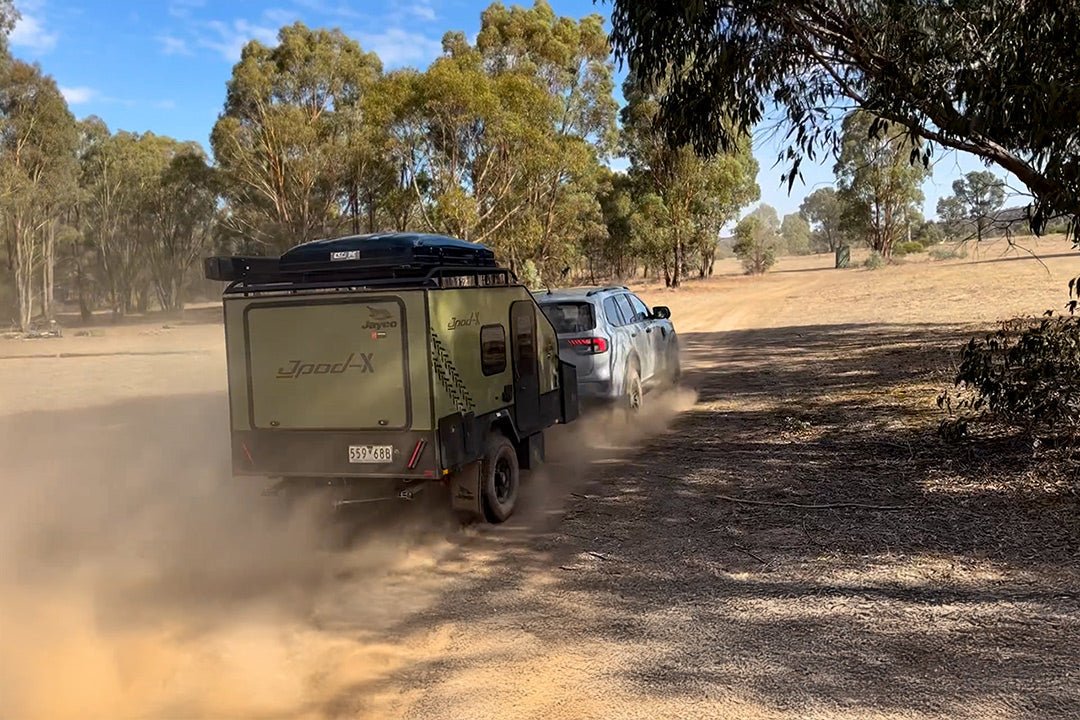KIMBERLEY KARAVANS BLACK CAVIAR KRUISER REVIEW

KIMBERLEY KARAVANS BLACK CAVIAR KRUISER REVIEW
• Sophisticated offroad caravan with a new design approach
• Front bedroom, rear bathroom design
• Panoramic views through windows
• High-energy battery and solar system
Every now and then, something quite different appears on the RV scene. Offroad caravans are reasonably common these days but Kimberley Kampers' Black Caviar Kruiser certainly stands out from the crowd. It looks like a motorhome from the rear and a fifth wheeler from the front, but is actually a caravan with some very unique features.
Caravan manufacturers design their vans from a variety of perspectives. Most build from design experience, some from user experience and others from customer feedback. So what do you do if you haven't built a full caravan before, and certainly never a purpose-built offroad caravan?
Kimberley Kampers, well-known for its offroad and hard-shell camper trailers, could certainly draw on its offroad experience, but it also asked its customers what they would like to see in a van. One of the answers which came back was the need for a 12V air-conditioner in the bedroom. You need 12V when camping out in the bush away from 240V mains power or without a generator. Anyone who knows anything about caravan air-conditioners will know that they usually have to run off 240V power because of the power requirements and associated cable sizes. Running a 12V air-conditioner would require a huge battery bank and a matching solar panel charging capacity, or a generator.
Kimberley Kampers owner Bruce Loxton and his design team gave the idea considerable thought and decided to give it a go. They started in the roof of the caravan and the challenge was to get enough solar panel capacity to charge up the batteries. The only way to do that was develop wafer-thin, high capacity panels and use high-tech lithium batteries.
After the solar panels had been designed, the body structure was put together. All the walls, as well as the roof, are built in an alloy Trellis Tube designed for strength and low weight. Smooth-looking fibreglass is used for the exterior, including the one-piece roof section. The elevated tropical roof is carbon fibre, an interesting choice over fibreglass. That is predominantly used by camper trailer manufacturers and consists of two roof layers with an air gap in between. It might sound simple but it's an arrangement that actually works surprisingly well.
The unique shape of the Black Caviar is created by the 'frameless' windows. They do actually have a frame, it's just not visible. The double-glazed polycarbonate windows match the paintwork and run along both sides of the caravan, coach and bus style. It is impressive from the outside and allows panoramic views from the inside. Naturally, the door isn't conventional either - it's a split door more akin to an aircraft than a caravan - and neither is the awning, which is fully recessed into the roof in what Kimberley calls a 'letterbox' style. It might sound odd but it looks, and works, a treat.
Betraying Black Caviar's camper trailer origins is the external kitchen which has a small slide-out stainless steel sink, slide-out Weber barbecue, a small amount of storage space and external speakers, all of which are very useful for al fresco living.
Kimberley has plenty of experience with chassis which, in this case, is built from hot-dipped galvanised steel with independent suspension for the tandem axles. The suspension has 4000kg trailing arms, coil springs and shock absorbers. The wheels and tyres are the customer's choice but they all come with electronically-operated disc brakes. Although disc brakes on caravans are a totally new concept, they have been designed to cope with rough-road travel. There are no cables or handles for the parking brake, which is just a simple one-touch operation.
ONBOARD STYLE
Stepping inside the Black Caviar is a bit like walking on to a raised observation platform because of all the windows. The van is fully fitted out for very classy travelling. The furniture is all alloy with a cherrywood timber finish. The layout is a conventional front bedroom/full-width rear bathroom design, but that's where the conventional part ends.
For a start, the four-person dinette not only has a multi-functional tri-fold table, but also aircraft-style reclining seats. You could recline the front pair and watch one of the two onboard TV screens.
On the opposite side, the kitchen bench is surprisingly large for a van like this. The black mock-granite benchtops are made from scratch-resistant acrylic. The stainless steel sink with ceramic taps and separate drinking water outlet is fairly standard, but the Webasto diesel-fired cooktop is not. There are various views on the diesel cooktop - startup time is longer, but it does mean one less fuel source on board. There's also a microwave oven/convection oven onboard. Instead of a conventional fridge/freezer, there are two Vitrifrigo units - an upright 133L 12V compressor fridge and a 55L twin-drawer freezer. That leaves space for five drawers of assorted sizes, a small slide-out pantry and four overhead lockers for additional storage.
Up front, the bedroom has a standard layout with a queen-size bed, side wardrobes and under-bed drawers, but it has a very classy and distinctive look about it. Part of the multimedia system (and I am not just talking about an AM/FM radio) is located on the offside bedside cabinet.
The rear bathroom has a glass circular shower cubicle with a seat, an electric flush toilet, a vanity cabinet with raised wash basin, a front-loading washing machine and a small drying cabinet kept warm via a diesel heater, which can also heat the whole bathroom if required.
WATER MANAGEMENT
Since we're talking bathroom, the water management system deserves a mention. There are two water tanks - one with a 120L capacity and one with 70L capacity. The larger one is designed for any water supply - town, dam or billabong - while the smaller one is restricted to drinking water only. At the rear, the 70L grey water tank has a separate pump and can be used to supply the toilet or washing machine. And, speaking of water, Kimberley claims the Black Caviar can be submerged to a depth of at least 0.7m, which is about the limit of most 4WDs.
The Black Caviar has full energy-efficient LED lighting and a sophisticated multimedia system with two drop-down TV screens, a Fusion radio with iPod socket, an antenna for extended range on the Telstra NextG network and a satellite. I should also mention that much of this system can be controlled from an iPad or iPhone with the appropriate apps.
On the towing front, the Black Caviar proved to be a very well-behaved tourer behind my Range Rover, despite its length of just over 7m (24ft) and loaded weight somewhere between 2500kg and 3000kg.
THE BOTTOM LINE
There's no doubt that an article this length does no justice at all to something like this Kimberley Black Caviar Kruiser. It's a very sophisticated piece of RV equipment, with all the necessary appointments, but at the same time its designed to take on the rough and tumble of Australia and is fully kitted out for offroad travel. If you're looking for an offroad caravan that was designed from the roof down (as opposed to the ground up), then the Black Caviar would be a good place to start.
I LIKED
• Fresh design approach
• 'Frameless' windows for an uninterrupted view
• Purpose engineered battery and solar panels
• Multimedia sound system
• Water management system
• Reclining seats
I WOULD HAVE LIKED
• Maybe a trip to the Flinders Ranges for a week.







